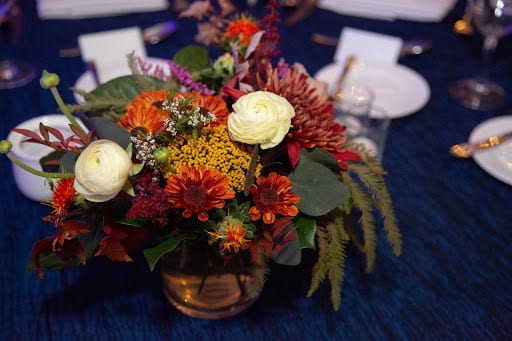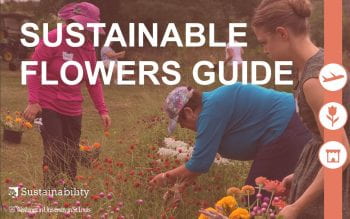Flowers add life and color to big events and small moments. Bringing nature inside, artistically arranged flowers transform a room from boring to welcoming, which is why we put them in the middle of our dining tables and the front of our halls. Cut flowers come from a wide variety of sources, and, like food, some of those sources are sustainable, while others are environmentally destructive. The information below provides a summary of sustainability considerations in the flower business.
What is Sustainable Floristry?
There is no single official definition of sustainability in the flower industry. Being a sustainable florist means making choices that protect the health of the earth, the environment, and the people touched in all aspects of the short life of a cut flower.

Environment
- Energy: The farther the flowers are grown from the end consumer, the more time spent in transit. Air freighting and trucking flowers long distances is energy intensive. Cut flowers must be refrigerated after harvest to ensure freshness. Cold-chain shipping in airplanes, trucks, warehouses and storage rooms require more energy than flowers grown close to the client.
- Chemicals: Imported flowers must be dipped in fungicides to comply with import regulations. Domestic flowers aren’t subject to foreign pest chemical protocols. Flowers grown with minimal pesticides and fertilizers protect the land, workers, and all who touch flowers.
- Land use: Some farmers steward their lands in more ecologically sound ways than others. For example, using minimal irrigation during growing and handling; protecting surrounding aquifers; making decisions that take biodiversity and habitat protection into consideration are ways to protect the health of the land.
- Florist Chemicals: Sprays, sheens and stabilizers used in florist studios to enhance the look and vase life of arrangements are often health hazards. In particular, floral foam (also called green foam or Oasis) doesn’t reasonably biodegrade and contains known carcinogens. Alternatives to floral foam are readily available (chicken wire, curly willow and pebbles are common substitutes.)
- Waste: Sustainable florists minimize landfilled debris by composting botanical scraps; choosing reusable, recyclable or compostable vases and containers; avoiding plastic decor in arrangements; and opting for recyclable, minimal packaging.
- Consumption: From field to vase, sustainable floristry means doing more with less, and making choices that minimize the environmental impact of cut flowers.
Society
- Wages: Fair pay for workers in the field and at the florist, while understanding the need for competitive pricing.
- Working conditions: Safe, healthy environments for workers in the field and at the florist.
- Exploitation: treating workers with respect and giving fair compensation.
- Education: Sharing information with suppliers, colleagues, consumers and the public about ways to promote sustainability in the flower trade.
Recommendations
- Utilize a recommended florist who has the ability to align with best practices of sustainable flower sourcing.
- Use this guide to communicate your sustainability goals and align your florist with best practices for green events.
- Locally grown flowers, when seasonally available, are more sustainable than alternatives. (Flowers native to your area are the most sustainable, as they protect biodiversity and require minimal inputs.)
- Domestically-grown, sustainably-certified flowers are a reasonable second choice. Veriflora, BloomCheck, Fair Trade and Rainforest Alliance are third-party certifiers who ensure that flowers marked with their logo have been checked for sustainability using ecological and societal impact metrics.
- Choosing flowers based on their sustainability sometimes means making aesthetic choices based on seasonal availability rather than color or varietal preferences. (Luckily, all flowers are beautiful.)
- In general, local and domestic flowers aren’t necessarily more expensive than import commodity flowers. Sustainable florists can work within a stated budget using local and certified domestic flowers. (Most designers find constraints artistically stimulating.)
Sustainable Flowers Guide
Discover more details about the importance of responsible flower sourcing and how to incorporate sustainable flowers into your next event.
This guide was produced by students in the Sustainability Exchange course at Washington University, under the supervision of faculty member Suzanne Langlois.

Sustainable Flowers FAQ
Most American florists buy cut flowers imported from South America. Favorable trade deals have grown flower farming into a huge industry in Latin America. In 1991, the Andean Trade Preference Act lifted duties on flowers grown in Columbia, Ecuador, Peru, and Bolivia. Suddenly, inexpensive roses, carnations and lilies were popping up in US florists and supermarkets. The market has continued to grow.
But the hidden costs are steep. Once a vibrant part of American agriculture, US fresh-flower farmers couldn’t compete with the low-priced commodity flowers being shipped in, and most domestic farmers went out of business. Today, only about a third of our fresh flowers are grown in the US.
Imported cut flowers may give us cheaper blooms, but their damage to human and environmental health is high. The industry relies on low wages. Child labor in the South American fields has decreased over the years due to international scrutiny, but workers can still be as young as school-aged.
Workers, water and land are exposed to significant amounts of chemicals. Herbicides and insecticides are standard in the trade, because blemished petals and stems redeem no profit. Flowers are a fragile commodity. To keep them intact for their long trip north, workers dunk them in preservatives and fungicides to maintain their look. Trade in flowers across borders sets up an inherent incentive to use chemicals, as governments don’t allow agricultural products into their countries that haven’t been treated for foreign pests. The USDA checks flowers for insects and disease, but not for chemical residues.
These chemicals get into the air in the fields, in the greenhouses and in the flower processing areas (some operators provide respirators for workers, some don’t.) And the chemicals remain on the flowers that wind up in vases in the middle of the dining tables. DFR or “dislodgeable foliar residues” transfer from plants to people by simply handling imported flowers.
To keep flowers fresh in transit, flower growers and exporters use cold chain distribution, keeping processing and storage areas, airline cargo holds, delivery trucks and display cases refrigerated to around 34 degrees. The near-freezing temperatures ensure that cut flowers stay fresh, but create a big carbon footprint in the process.
Local flowers offer an abundant variety of color and bloom choice, because the flowers don’t travel far from the field to the vase. Commodity imports are restricted to heartier stock, which is the reason mass-market arrangements tend to be monotonous.
Local flower farmers harvest what’s in season, so the palette of flower arrangements reflects nature’s authentic beauty in the moment.
Local flowers grown in open fields provide habitat and food for pollinators. Butterflies, bees and birds all benefit from field-grown flowers. Plant and animal life up and down the food chain, in turn, benefit from the pollinators’ activity. Native flowers are even more beneficial, since plants naturally occurring in the ecosystem attract a wider array of pollinators.
Local flower farmers typically don’t use a heavy load of chemicals, since their blooms travel shorter distances and aren’t subject to customs regulations. Most use sustainable growing practices, such as Integrated Pest Management.
The short distances local flowers travel means less of a carbon footprint from field to vase: shorter time in refrigerated storage, fewer miles on the road, no time in an airplane.
Local flower farms provide employment for the community. They are an important educational resource in the community, hosting tours, encouraging inquiry into horticulture and sharing knowledge with florists and others in the industry. Many farmers participate in weekly farmers markets, allowing individuals to not only buy small quantities of fresh cut flowers, but also to get to know their growers and their seasonal offerings.
Transparency inherent in local sourcing promises integrity in the buying process.
Yes, a number of American flower farmers participate in third-party certification programs (Veriflora, Bloomcheck, Fair Trade, Rainforest Alliance) which ensure that the cut flowers they sell have been sustainably grown. While the certification programs are used by both domestic and imported flower growers, American-grown flowers have an overall reduced environmental impact primarily because of the shorter distance from grower to buyer.
First, ensure the florist you’re buying from is using locally grown flowers and greens whenever possible. When not available, sustainably-certified domestic flowers are a sound option.
Secondly, seek out florists who routinely incorporate environmentally conscientious practices into their work – avoiding floral foam and minimizing landfilled waste are two key practices.
Request for Proposals: Are you a florist that would like to be added to our list of preferred florists? Apply and commit to the sustainability pledge. We will be in touch soon to verify your submission.